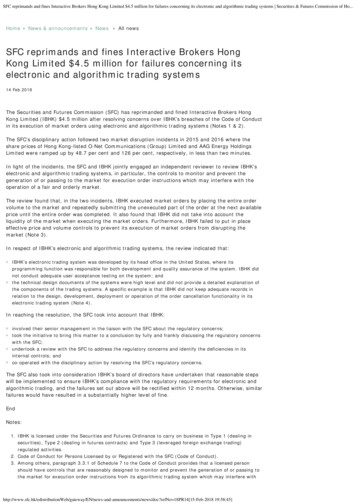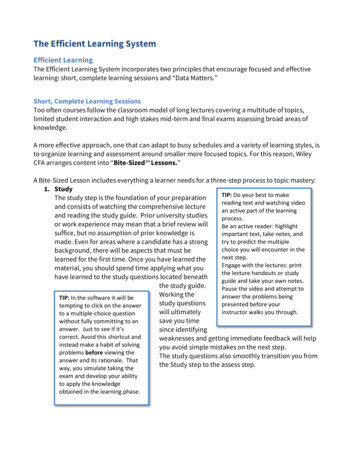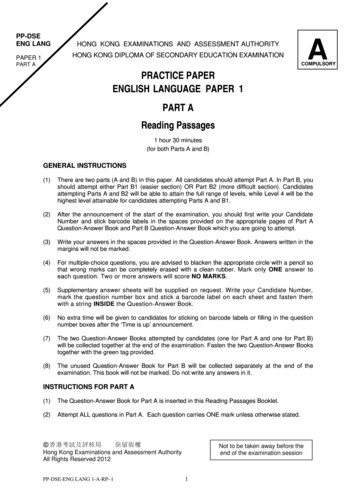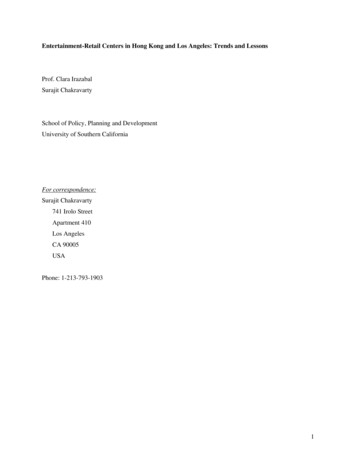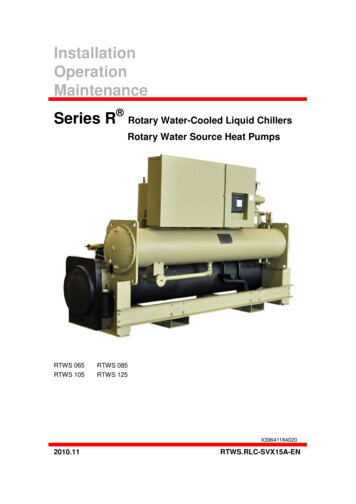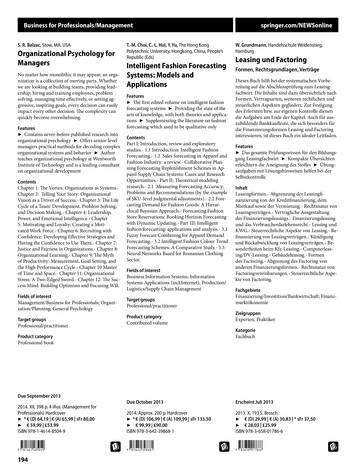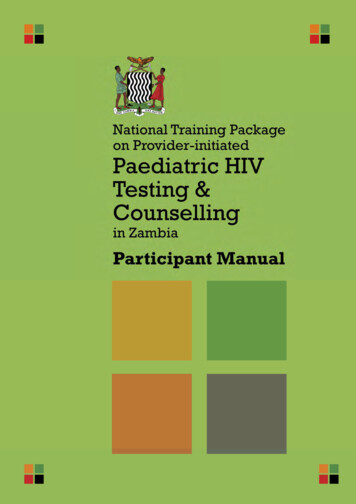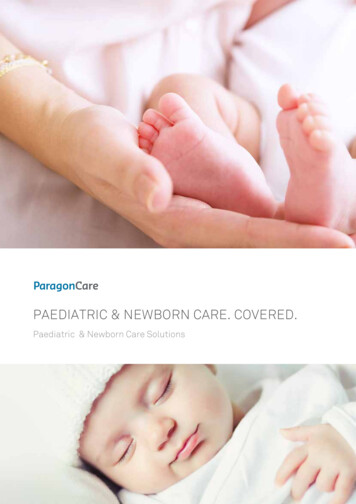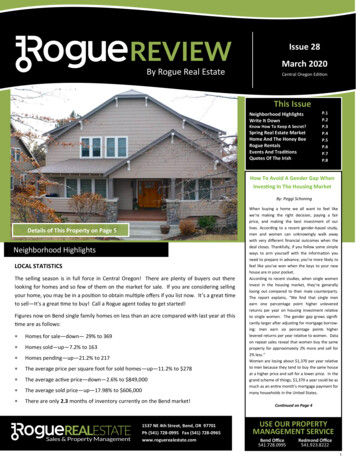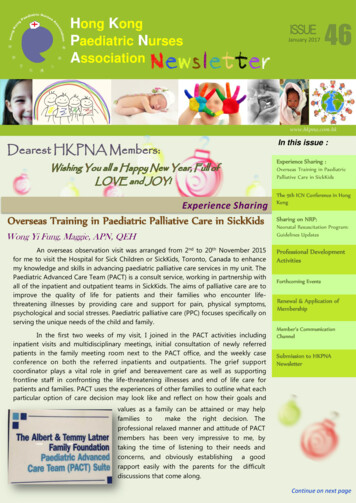
Transcription
Hong KongPaediatric NursesAssociationISSUEJanuary 201746www.hkpna.com.hkIn this issue :Dearest HKPNA Members:Experience Sharing :Overseas Training in PaediatricPalliative Care in SickKidsExperience SharingOverseas Training in Paediatric Palliative Care in SickKidsWong Yi Fung, Maggie, APN, QEHAn overseas observation visit was arranged from 2nd to 20th November 2015for me to visit the Hospital for Sick Children or SickKids, Toronto, Canada to enhancemy knowledge and skills in advancing paediatric palliative care services in my unit. ThePaediatric Advanced Care Team (PACT) is a consult service, working in partnership withall of the inpatient and outpatient teams in SickKids. The aims of palliative care are toimprove the quality of life for patients and their families who encounter lifethreatening illnesses by providing care and support for pain, physical symptoms,psychological and social stresses. Paediatric palliative care (PPC) focuses specifically onserving the unique needs of the child and family.Feature StoryIn the first two weeks of my visit, I joined in the PACT activities includinginpatient visits and multidisciplinary meetings, initial consultation of newly referredpatients in the family meeting room next to the PACT office, and the weekly caseconference on both the referred inpatients and outpatients. The grief supportcoordinator plays a vital role in grief and bereavement care as well as supportingfrontline staff in confronting the life-threatening illnesses and end of life care forpatients and families. PACT uses the experiences of other families to outline what eachparticular option of care decision may look like and reflect on how their goals andThe 9th ICN Conference in HongKongSharing on NRP:Neonatal Resuscitation Program:Guidelines UpdatesProfessional DevelopmentActivitiesForthcoming EventsRenewal & Application ofMembershipMember’s CommunicationChannelSubmission to HKPNANewslettervalues as a family can be attained or may helpfamilies tomake the right decision. Theprofessional relaxed manner and attitude of PACTmembers has been very impressive to me, bytaking the time of listening to their needs andconcerns, and obviously establishing a goodrapport easily with the parents for the difficultdiscussions that come along.Continue on next page
HKPNAPACT’s main task is helping people negotiate the overwhelming anxieties about death, suffering, lovedones and finances. They used to have many worries and terrors. No one conversation can address them all. PACTis trying to learn what is the most important to the patient and family under the circumstance so thatinformation and advice can be provided in an approach that is appropriate to the patient and family. Theprocess requires as much listening as talking.In the situation of PPC in the neonatal unit, the parent's unwillingness to accept that nothing more canbe done for an incurable ill infant makes a particular challenge to the PACT. Nevertheless, in the youngadolescent, life-threatening illness perspective is shaped by the child's developmental context, which includespsychological, emotional, and spiritual changes in addition to the physical transitions. The complexity ofthoughts leads to greater reflection regarding his or her beliefs and wishes about death.With the special characteristics of children at the different developmental stages, treatment goals maydiffer among patients and families to meet their individualized needs. However healthcare providersinadequately prepared in the understanding of the concept of quality of life in the paediatric patients may delaythe introduction of PPC services and thus prolonging the undue physical pain of children as well as theemotional and psychological sufferings of their parents. One of the greatest barriers for developing andimplementing palliative care service in the Chinese society of Hong Kong is the cultural perception andmisconceptions about palliative care. Chinese culture is used to consider death as a taboo and believe thattalking about death in front of a terminally ill patient will bring bad luck for patient’s health and recovery.Palliative care is commonly perceived as “caring for a dying person” in some parents who may feel that, byaccepting PPC, child may not be provided with the best possible care and so leading to a preference for activeresuscitation by all means to conservative interventions designed to reduce suffering and provide comfort andsupportive care.The PACT model in SickKids inspires me greatlyto pay attention to deliver PPC care in Hong Kong. PPC isalso family-centered care. The incorporation ofmultidisciplinary approach can also be emphasized inevery aspect of care delivery. It promotes thecommunication and coordination of care services. Withthe close communication among palliative care providers,families are better able to choose the plan of care optionsthat are in line with their values, traditions and culture. Itimproves the well-being of the entire family. While griefand bereavement care are continuing to bereinforced in Hong Kong, however lack of structured professional PPC service and the comprehensive trainingon PPC of health care providers and administrators are the important identified factors for the underdevelopment of PPC service in the Chinese society of Hong Kong. As the health professionals well placed atpatients’ bedside and the community, nursing staff should be well-equipped with essential PPC skills as thebasic competency to meet the paediatric standard of care delivery worldwide. Healthcare administrators andpolicy makers should consider the provision of comprehensive PPC service to meet up with the futurehealthcare reforms and challenges.ReferenceWIENER, L., MCCONNELL, D., LATELLA, L. and LUDI, E. (2013). Cultural and Religious Considerations in Paediatric Palliative Care.Palliative Support Care, February, Vol.11(1): 47-67.
HKPNAExperience SharingThe 9th ICN Conference in Hong KongChan Yin Ling, APN, UCHThe 9 th International Council of Nurses (ICN), International Nurse Practitioner /Advanced PracticeNursing Network (INP/APNN) Conference, 9-11 September 2016, was held in Hong Kong at the HKConvention and Exhibition Centre (HKCEC). This was a very important event in the global nursing agenda, andprovided a platform for our professionals from different countries to conduct academic exchange andpromote public health globally. The host organizer was the Hong Kong Academy of Nursing (HKAN) and coorganized with College of Nursing, Hong Kong (CNHK) and the World Health Organization CollaboratingCentre for Community Health Services (WHOCC) and the Hong Kong Polytechnic University.The key theme of the Conference was ‘Advancing Nursing, Advancing Health: Emerging Possibilities’.There were nearly 1000 delegates from around the world to join and over 400 abstracts were received. I washonoured to be one of the oral presenters. My topic was “Implementation of Nurse Residency Program in aNeonatal Unit: Experience of a Regional Hospital in Hong Kong.A survey evaluated a two-year transition-to-practice program tohave engaged the new nurses in safe practice, to haveconfidence and reduce their stress in new clinical environment.Both twenty-eight new nurses and twenty preceptors wererecruited in the survey. The result was statistically significant inimproving the new nurses’ knowledge, confidence and reducingtheir stress level. Also, nurses were more willing to stay in theunit after the program. It was a valuable experience to share withnursing colleagues internationally.The subthemes of both the oral and posterpresentation were related to the scientific approach ofadvanced practice nursing (APN) in nursing services,clinical practice and patient outcomes. Thepresentation provided an excellent opportunity toreflect on the challenges and emerging possibilities inachieving a strong future for the advanced practicenurses as well as nursing profession. In addition, therewere six workshops – Advancing Nursing Practice inNurse Clinic in the 21 st Century, Massage therapy inAdvanced Nursing Practice, the Omaha System: a keyto practice, documentation and information management, The OSCE: creating and implementing a programfor your teaching environment, Prescribing and Nursing Entrepreneurship with renowned international expertsto provide the participants with a unique interactive learning experience. Besides, the Conference was alsocomplemented by the social programs – the Gala Dinner, Hong Kong Night and Tai Chi Class.
HKPNAOverall, this 9th ICN Conference demonstrated and advanced the nursing contributions to health in theworld. This also supported nursing’s contribution to evidence-based healthcare and to have encouragedproblem solving approaches to health priority needs. Most importantly, this biennial ICN Conference heldaround the world provides a platform for in-depth exchange of experience and expertise within nursingprofession internationally.Tai Chi class led by Tai Chi Masters at the HKCEC,discovering the serenity from balancing the mindand bodyPaediatric nurses at the HK Night with culturalperformanceLast but not the least, I would like to recommend this ICN conference which would be held regularly toour fellow paediatric nurses of both the public and private sectors in Hong Kong.Sharing on NRPNeonatal Resuscitation Program: Guidelines UpdatesCHAN Man Yi, NC, PMHThe neonatal resuscitation program (NRP) was initiated by the American Academy of Pediatrics and theAmerican Heart Association (AHA) in 1987. Standards for NRP are propelled by guidelines defined byhealthcare professionals, and accrediting organizations. It is to ensure safety during the resuscitation andstabilization of newborn infants. A structured Neonatal Resuscitation Program (NRP) has been proven to gainsignificant improvement in management of newborn infants at resuscitation. It is obvious that the need forsimulation-based training NRP is evolving as the new training practice approach.Simulation-based training on NRPThe simulation-based training with standard operating procedures is structured to guide theparticipants in safe neonatal resuscitation practices for better outcome for newborn infants. There is the needof implementing the standardized neonatal resuscitation training and guideline for all healthcare professionalsacross the various hospital settings in perinatal and neonatal care services of Hong Kong. NRP aims forhealthcare professionals to grasp the neonatal resuscitation techniques and to enhance team collaboration toimprove the success rate of recovery, and effectively reduce the mortality and disability rate of the newborninfants.continue on next page
HKPNAThe developmental consideration for neonatal resuscitation focuses on the essential componentsincluding initial steps in stabilization of the newborn, oxygen administration, positive pressure ventilation, chestcompressions, the use of drugs, and intubation. Besides, the key skills during neonatal resuscitation are effectiveteamwork and communication in addition to the acquired resuscitation knowledge and skills in order to besuccessful. Nevertheless, the simulation-based approach on NRP emphasizes on communication skills with preand post-resuscitation team briefing, and team collaboration training for effective teamwork andcommunication among the resuscitation team members. NRP courses is flourishing in Hong Kong with theinstructors and trainers increasing in the healthcare settings.ConclusionNeonatal resuscitation program is updated by the AAP regularly following the recommendation ofresuscitation guideline updates to AHA from after the evidence review and International Consensus onCardiopulmonary Resuscitation and Emergency Cardiovascular Care via the International Liaison Committee onResuscitation (ILCOR). With the guideline updates in NRP (2015) and the increasing nurses and doctors whohave received the updated simulation-based training, it is hoped that the best evidence based neonatalresuscitation guidelines will be promulgated across the various hospital settings in HK.Reference:Myra, H.W et al (2015). Part 13: Neonatal resuscitation. 2015American Heart associationGuidelines Update forcardiopulmonary resuscitation and emergency cardiovascular care.Circulation:132 (supp 2) S543-S560Chan J., Chan B., Ho H.L., Chan K.M., Kan PG, Lam H.S. (2016), Theneonatal resuscitation algorithm organized cart is more efficientthan the airway-breathing-circulation organized drawer: acrossover randomized control trial. European Journal ofEmergency Medicine, 23(4), 258-262.For Neonatal Resuscitation Algorithum 2015Update, please articipant nurses and doctors in the updated simulation-based NRP training in HKNRP Guidelines Updates 2015 – Points to Note: Umbilical Cord Management Delayed cord clamping for 30-60 seconds isreasonable for most vigorous term & preterm infants; suggested against the routine use of cord milking forinfants born at less than 29 weeks of gestation; Heart rate (HR) remains the most importantindicator of successful resuscitation; Initial HR assessment – auscultation PPV begin – consider ECG monitoring When/if chest compressions begin – ECG ispreferred method to determine HR. Temperature stabilization – emphasis on maintainingnormal temperature in delivery room; Focus intently on achieving effective ventilation Routine tracheal suction no longer recommended for nonvigorous babies with meconium stained fluid; Strongly recommended intubation prior to chestcompressions. Every delivery area must have an oximeter; Administer drug- Epinephrine and/or volume. Initial Oxygen concentrationventilation (PPV): 35 weeks GA: 21% 35 weeks GA: 21-30%forpositivepressure IV route preferred, pre-hospital setting mayconsider using intraosseous needle Team debriefing and reflection are key to improvingperformance .
HKPNACall for Submission
Hong Kong Paediatric Nurses Association In this issue : ISSUE www.hkpna.com.hk Feature Story January 2017 46 Overseas Training in Paediatric Palliative Care in SickKids An overseas observation ndvisit was arranged from 2 to 20th November 2015 for me to visit the Hospital for Sick Children or SickKids, Toronto, Canada to enhance
